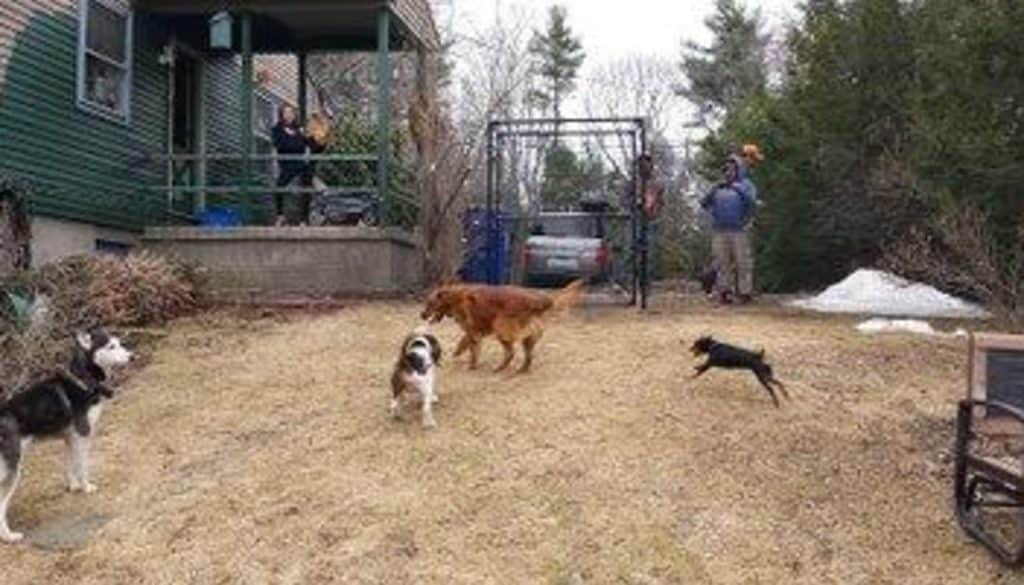At Petplaygrounds Non electric dog fence, we understand that every dog is unique. Their size, breed, and behavior all play a role in determining the right fence for their safety and comfort.
A customizable fence is essential to address the specific needs of your furry friend. This blog post will guide you through tailoring your fence to your dog’s individual characteristics, ensuring a secure and happy environment for your pet.
How Different Dog Sizes and Breeds Affect Fencing Needs
Size Categories: Small, Medium, and Large Dogs
Dog size plays a significant role in determining the right fence. Small dogs (under 20 pounds) need fences with smaller gaps to prevent escape. A Chihuahua, for instance, might easily slip through spaces that would contain a larger breed. Medium-sized dogs (20 to 60 pounds) require sturdier fencing materials to withstand their increased strength. Large dogs (over 60 pounds) demand the most robust fencing solutions due to their size and power.
Breed-Specific Behaviors and Fencing Solutions
Different breeds exhibit distinct traits that impact fencing requirements. Huskies and Malamutes, known for their escape artist tendencies, need fences at least 6 feet tall with anti-climb features. Terriers, with their natural digging instincts, benefit from fences with dig guards or underground extensions. Greyhounds, capable of incredible speeds, require fences without gaps they could accidentally run into and injure themselves.
Energy Levels and Exercise Needs
A dog’s energy level significantly influences fencing decisions. For high jumpers like Border Collies and Whippets, the fence height is even more critical, often necessitating a minimum of 6 feet to ensure their containment. High-energy breeds need ample space within their fenced area for exercise and play. Less energetic breeds might be content with smaller fenced spaces, but still require enough room for comfortable movement and bathroom breaks.
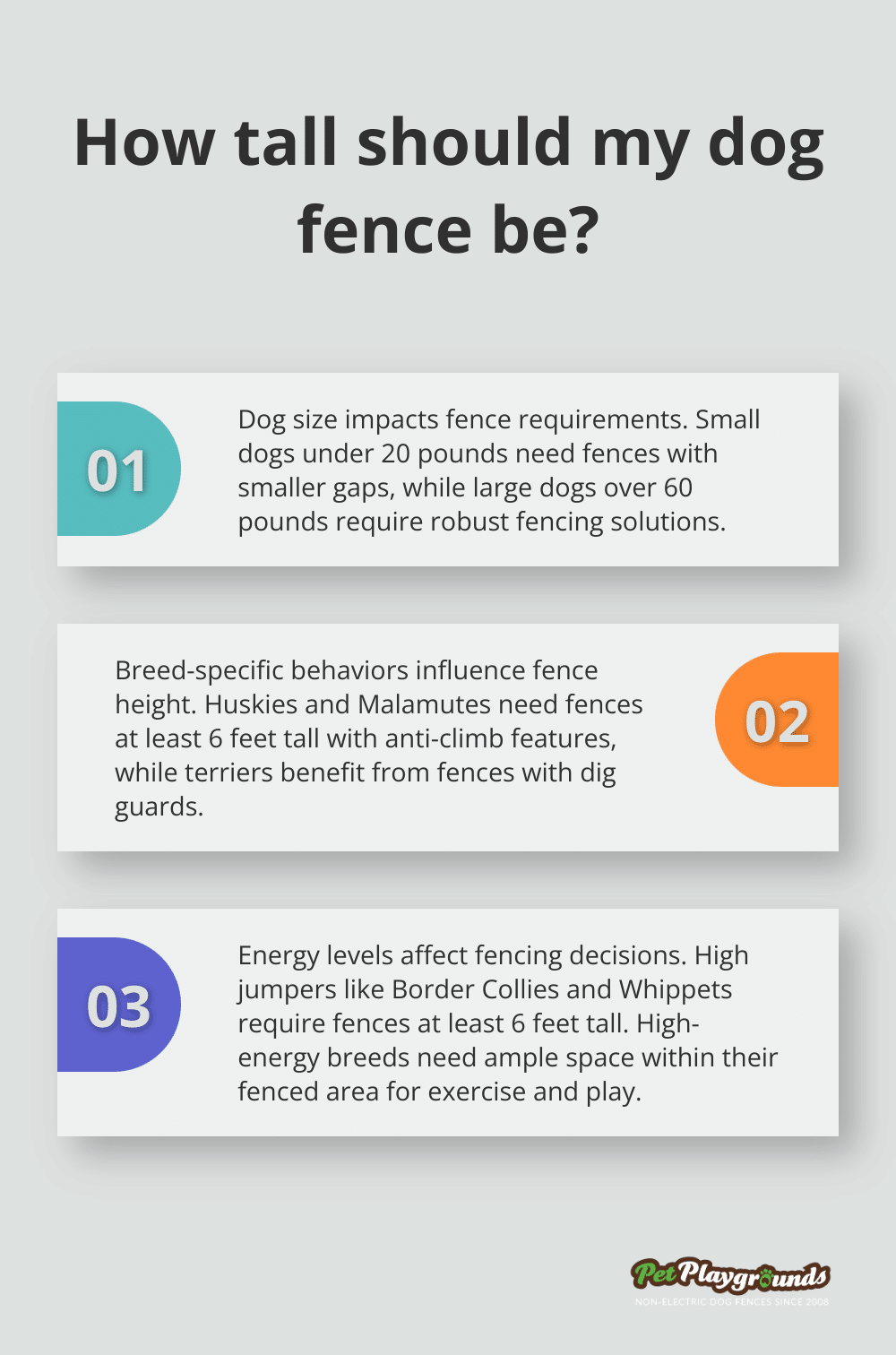
The fence should accommodate your dog’s daily exercise requirements. A fence that creates a “Private dog park” can improve your pet’s health and behavior by providing a safe space for regular activity. This is especially important for working breeds that need mental and physical stimulation to prevent destructive behaviors.
Customization for Optimal Security
The right fence not only keeps your dog safe but also enhances their quality of life. A tailored fencing solution that considers your dog’s size, breed characteristics, and energy levels creates a secure and enriching environment. This approach supports their well-being and happiness while providing peace of mind for pet owners.
As we move forward, let’s explore how fence height plays a crucial role in ensuring your dog’s safety and containment.
How Tall Should Your Dog Fence Be?
Small Dogs and Lower Fences
For small breeds under 20 pounds, a 4-foot fence often suffices. However, some small dogs surprise owners with their agility. Jack Russell Terriers or Miniature Pinschers might require a 5-foot fence to prevent escapes.
Medium and Large Dogs Demand Taller Barriers
Medium-sized dogs typically need fences between 5 and 6 feet tall. Large breeds, especially those known for their jumping abilities (like Greyhounds or German Shepherds), often require fences at least 6 feet high. Some exceptionally athletic or determined dogs might even need 7 or 8-foot fences.
Adjustments for Jumpers and Climbers
Dogs with strong jumping or climbing instincts pose unique challenges. For breeds like Samoyeds, it is recommended to use a high wooden, vinyl, or composite fence. These additions make it much harder for dogs to clear the top or gain a foothold for climbing.
Extra Security Features
Height alone doesn’t always keep determined dogs contained. Additional security features enhance containment effectiveness. Dig guards extend underground to prevent tunneling, while chew-resistant materials discourage fence destruction.
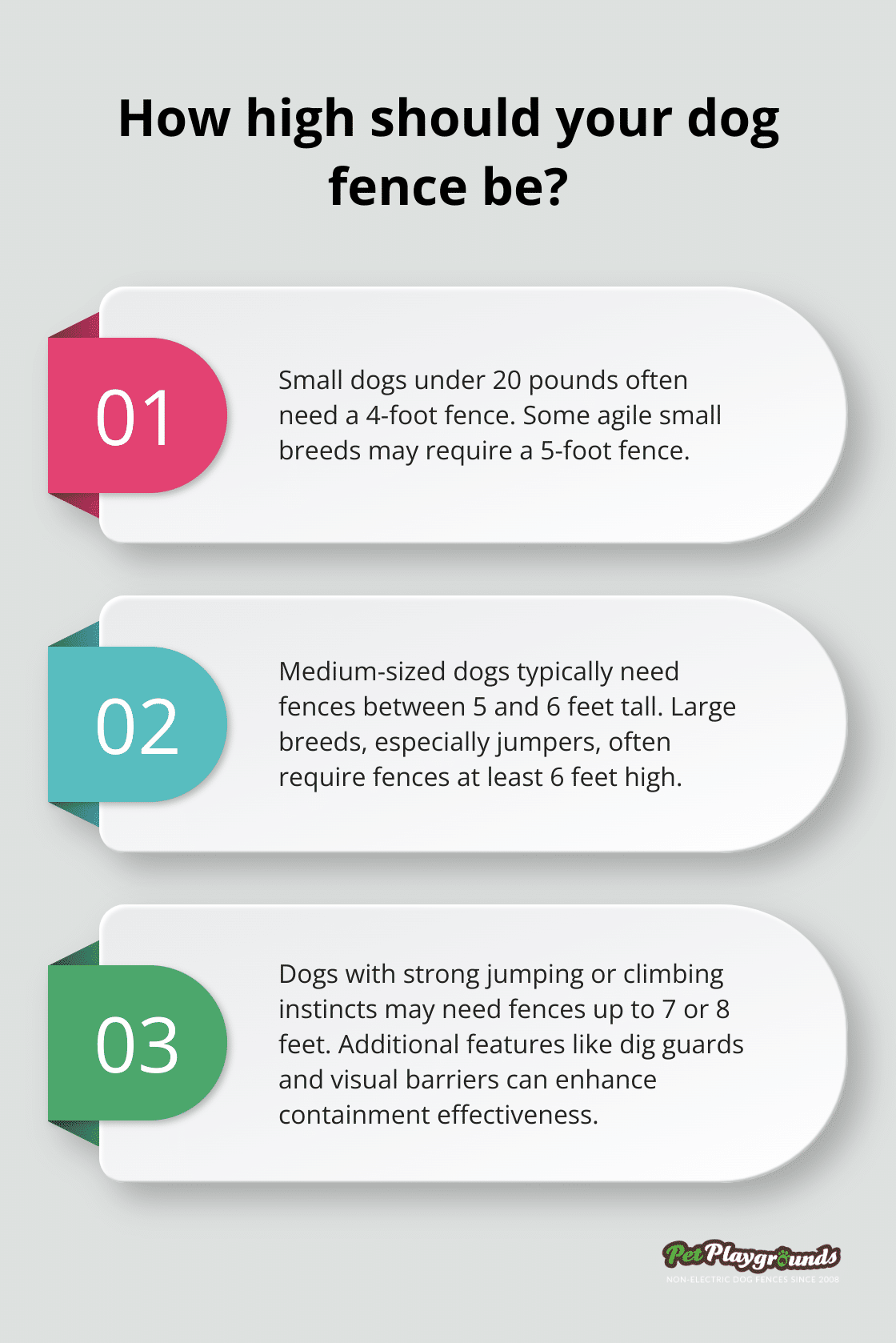
Visual barriers can benefit dogs that become overstimulated by outside activity. Solid panels or privacy slats reduce barking and fence-running behaviors.
Customizing Your Fence Height
While these guidelines help, every dog is unique. Factors like age, physical condition, and training level all influence the ideal fence height. We suggest you observe your dog’s behavior and consult with a fencing professional to find the perfect solution for your pet.
A properly sized fence not only keeps your dog safe but also provides them with a secure space to play and exercise. This can significantly improve your dog’s overall health and happiness, transforming your backyard into a private dog park.
Now that we’ve covered fence height, let’s explore how proper spacing and materials can further enhance your dog’s safety and comfort in the next section.
Choosing the Right Fence Spacing and Materials
Gap Sizes for Secure Containment
The spacing between fence components plays a vital role in preventing escapes. Small dogs require gaps no larger than 2 inches, while medium-sized dogs need spaces up to 4 inches. Large breeds can be contained with gaps up to 6 inches. (These measurements serve as general guidelines and may vary based on your dog’s specific build and behavior.)
Pet Playgrounds Non-Electric Dog Fence uses a poly mesh with small openings that prevent even the tiniest dogs from squeezing through. This design eliminates the need to determine the right gap size for your pet.
Durable Materials for Persistent Dogs
Dogs that chew or dig demand extra-durable fencing materials. For diggers, you might need to reinforce the kennel’s foundation with chicken wire or gravel. However, outdoor kennels can be restrictive and may not be the best solution for all dogs. Some fences (like those offered by Pet Playgrounds) come with built-in dig guards and chew-deterrent coatings.
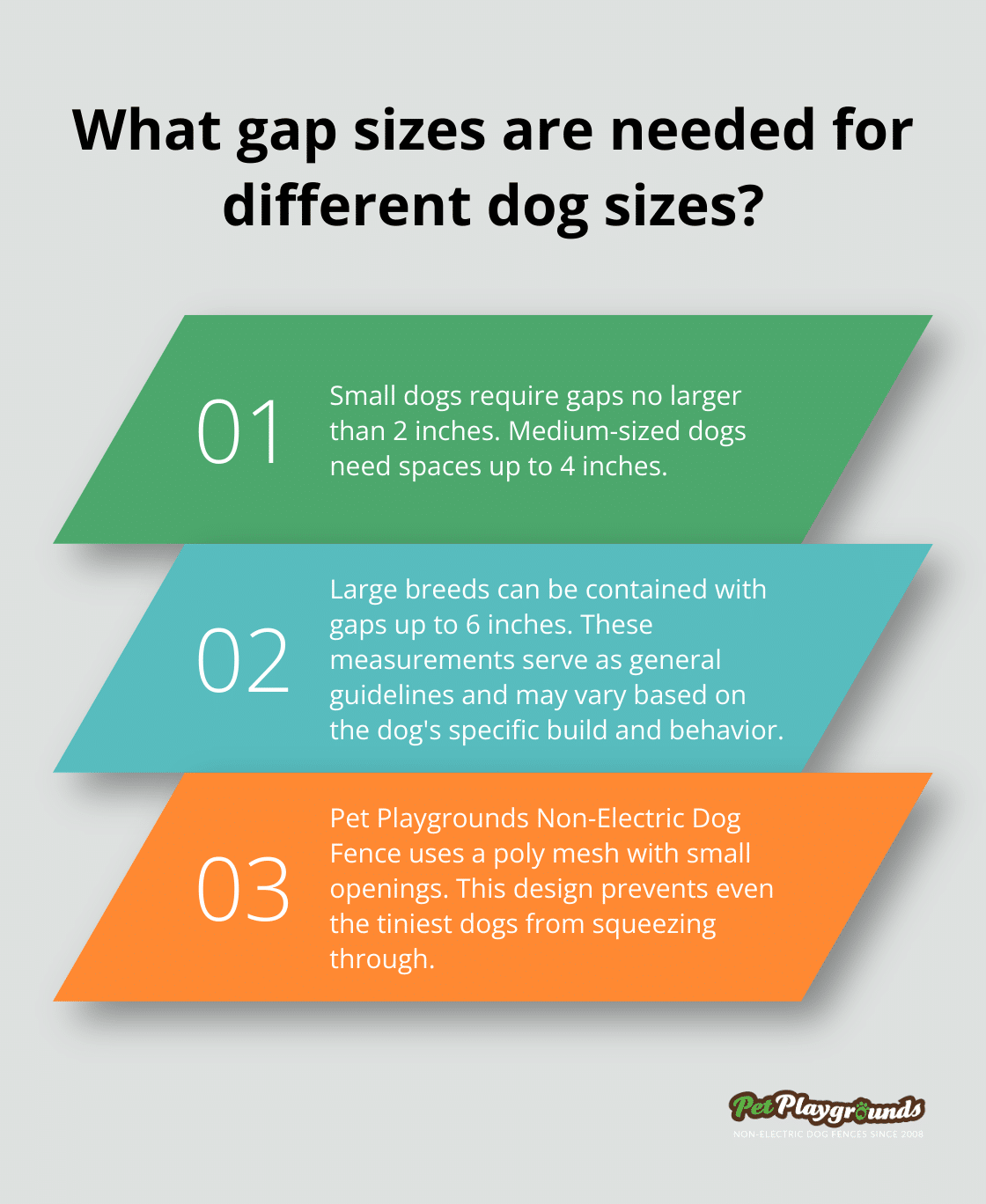
Persistent chewers benefit from fences made of galvanized steel or coated with a bitter spray. Pet Playgrounds’ poly mesh includes a Bitter Pro infusion that naturally deters chewing, providing an additional layer of protection.
Weather-Resistant Options for Long-Lasting Performance
Outdoor fences face constant exposure to the elements, making weather resistance a top priority. Vinyl fences excel in this area, as they resist rot, rust, and fading. Aluminum serves as another excellent choice due to its corrosion resistance.
Wood fences, while popular, require regular maintenance to withstand weather conditions. Wooden fences are made of whole, tall slat boards and can be weather-resistant and long-lasting, but they can be expensive and not provide much privacy.
Customizing Your Fence
The right combination of spacing, durability, and weather resistance creates a secure and enjoyable outdoor space for your canine companion. Consider these factors alongside your dog’s specific needs when selecting your fence. A well-chosen fence not only keeps your dog safe but also provides peace of mind for years to come.
Final Thoughts
A customizable fence tailored to your dog’s unique characteristics ensures their safety, happiness, and overall well-being. Different dog sizes, breeds, and behaviors influence fencing needs, from height considerations to spacing and material choices. Every aspect of your fence can be customized to create the perfect outdoor environment for your furry friend.
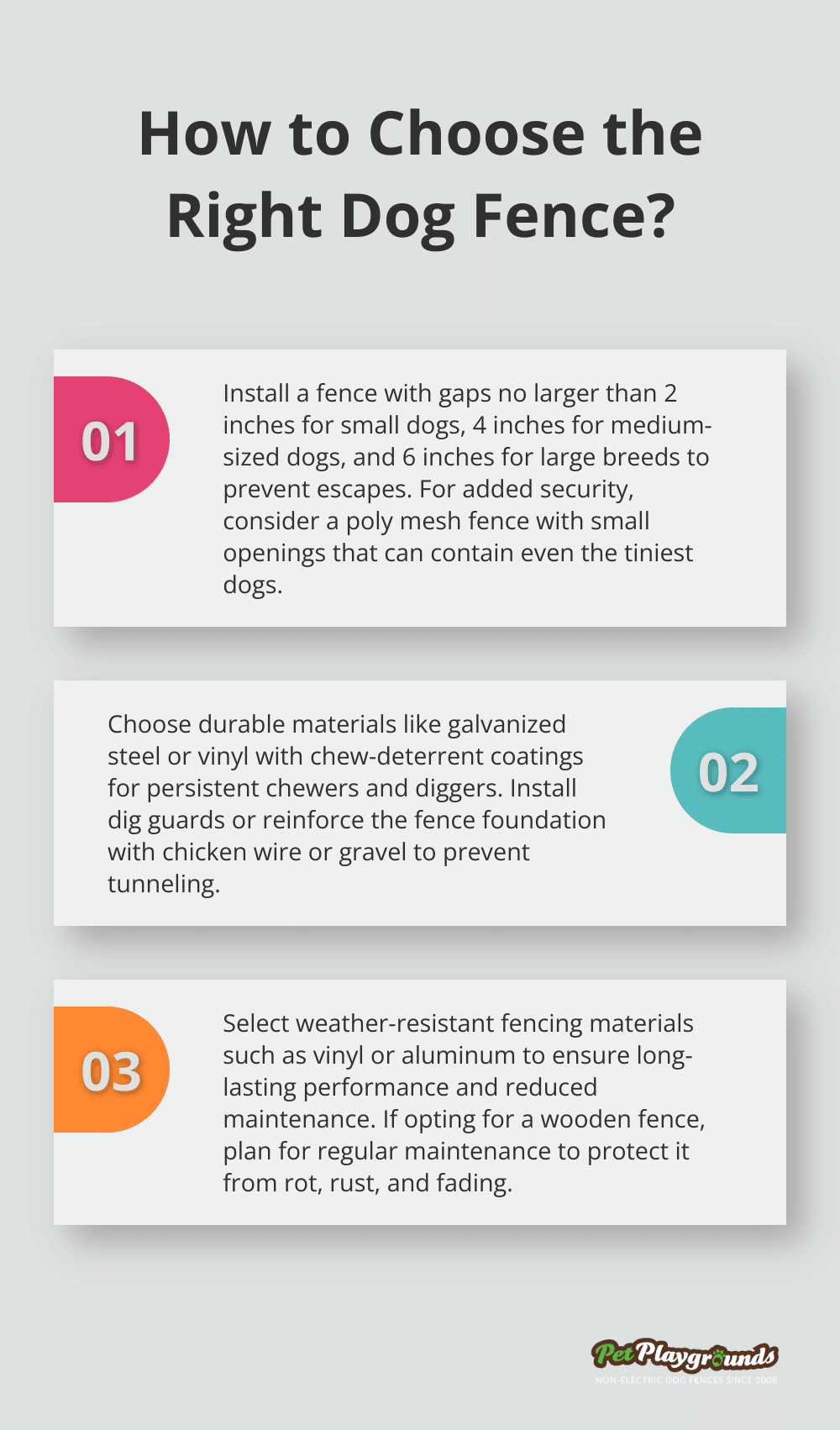
A properly tailored fence system creates a safe haven where your dog can exercise, play, and explore without the risk of escape or injury. This private outdoor space can improve your dog’s physical health, mental stimulation, and overall quality of life. It also offers peace of mind for you as a pet owner, knowing that your beloved companion is secure and happy.
At Pet Playgrounds, we understand the importance of a customizable fence that meets the unique needs of your dog. Our Non-Electric Dog Fence offers a versatile solution that adapts to various dog sizes and behaviors (with features like Bitter Pro-infused poly mesh, dig guards, and an anti-climb design). You’re not just investing in a barrier; you’re creating a private dog park that can transform your pet’s life, health, and even trainability.



